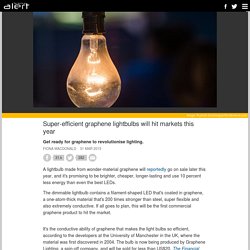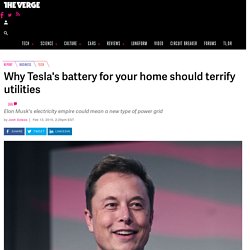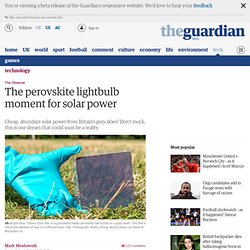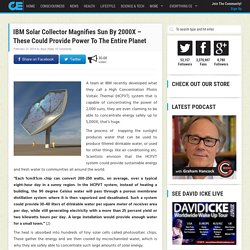

Super-efficient graphene lightbulbs will hit markets this year. A lightbulb made from wonder-material graphene will reportedly go on sale later this year, and it's promising to be brighter, cheaper, longer-lasting and use 10 percent less energy than even the best LEDs.

Why Tesla's battery for your home should terrify utilities. Earlier this week, during a disappointing Tesla earnings call, Elon Musk mentioned in passing that he’d be producing a stationary battery for powering the home in the next few months.

It sounded like a throwaway side project from someone who’s never seen a side project he doesn’t like. But it’s a very smart move, and one that’s more central to Musk’s ambitions than it might seem. To understand why, it helps to look not at Tesla, but at SolarCity, a company chaired by Musk and run by his cousin Lyndon Rive. SolarCity installs panels on people’s roofs, leases them for less than they’d be paying in energy bills, and sells surplus energy back to the local utility. Doing more with less. The Rodin Coil: Is It The Greatest Discovery of All Time? Free energy is easily one of the hottest topics in the world within alternative news.

While mainstream news continues to ignore the growing interest around the subject, alternative news outlets are providing new information about the inventions, science, mathematics and suppression of free energy technologies. Free Energy Devices: Yes They Are Real. Who is benefiting from suppressing scientific research?

Whose power and wealth is threatened by access to clean and free energy? Who has the desire to create a system where so few have so much, and so many have so little? It’s become extremely obvious, especially within the past few years, that Earth’s dependence on fossil fuels is not needed at all. Yet we continue to create war, destroy the environment and harm mother Earth so we can continue using the same old techniques that generate trillions of dollars for those at the top of the energy industry.
The perovskite lightbulb moment for solar power. The worst part of my job as a materials scientist is going to conferences.

They are often turgid affairs conducted in the ballrooms of hotels so identical to one another that you can't tell whether you are in Singapore or Manchester. The same speakers are there, for the most part droning on about the same thing they droned on about at the last conference. I should know, I am one of them.
But occasionally, just occasionally, someone says something so radically new that it causes you sit up and actually listen. Wilson Solar Grill for outdoor cooking - National Green Living. A group of MIT students have been working on a solar grill that uses a Fresnel lens and solar energy to melt down a container of Lithium Nitrate, which is like a battery storing thermal energy for 25 hours.

The heat created at temperatures above 450 degrees Fahrenheit is used for convection cooking outdoors. The MIT students are Derek Allen Ham, Eric Uva, and Theodora Vardouli. The project is part of their Innovation Teams, or iTeams, multi-disciplinary course taught by Fiona Murray at Sloan School in May 2011. The study is to do an entrepreneurial survey of product interest and business model plan for solar grill manufacture and distribution, both in third world countries like Nigeria and the U.S. where it might be an easier sell. Most developing countries may not be able to afford the cookers where their current source of heat, firewood, is free. IBM Solar Collector Magnifies Sun By 2000X – These Could Provide Power To The Entire Planet. A team at IBM recently developed what they call a High Concentration Photo Voltaic Thermal (HCPVT) system that is capable of concentrating the power of 2,000 suns, they are even claiming to be able to concentrate energy safely up to 5,000X, that’s huge.

The process of trapping the sunlight produces water that can be used to produce filtered drinkable water, or used for other things like air conditioning etc. Scientists envision that the HCPVT system could provide sustainable energy and fresh water to communities all around the world. “Each 1cmX1cm chip can convert 200-250 watts, on average, over a typical eight-hour day in a sunny region. Abengoa to build 110MW solar tower storage plant in Chile. Spanish solar energy developer Abengoa has won a contract to build a 110MW solar tower project with storage in Chile, the first project of its type in Latin America.

The project will have 17.5 hours of storage through the use of molten salts. Given that the Atacama desert where the plant is located has the best solar resources in the world, the plant will be able to provide power virtually without interruption if required. The Cerro Dominador plant follows the construction of a similar sized plant in Nevada by US company Solar Resource. Abengoa has begun construction of a similar but smaller plant in South Africa, the 50MW Khi Solar One facility in South Africa, which will have two hours of storage. Moss used as "biological solar panels" to power a radio. Swiss designer Fabienne Felder has worked with University of Cambridge scientists Paolo Bombelli and Ross Dennis to develop a way of using plants as "biological solar panels".

"Theoretically any photosynthesising plant could be used as a biological solar panel", said the team, which has developed what it calls Photo Microbial Fuel Cells (Photo-MFCs) to capture and harness the electrical power of plants.